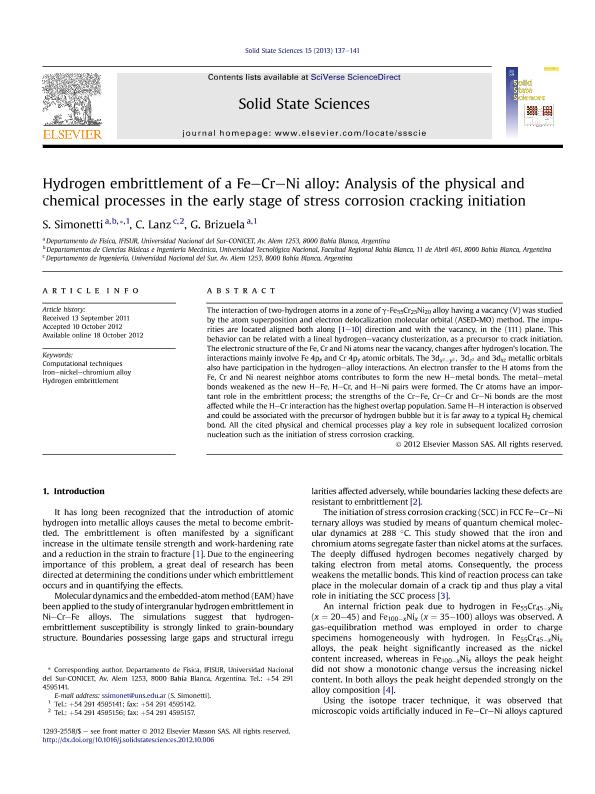Artículo
Hydrogen embrittlement of a Fe-Cr-Ni alloy: Analysis of the physical and chemical processes in the early stage of stress corrosion cracking initiation
Fecha de publicación:
01/2013
Editorial:
Elsevier
Revista:
Solid State Sciences
ISSN:
1293-2558
Idioma:
Inglés
Tipo de recurso:
Artículo publicado
Clasificación temática:
Resumen
The interaction of two-hydrogen atoms in a zone of g-Fe55Cr25Ni20 alloy having a vacancy (V) was studied by the atom superposition and electron delocalization molecular orbital (ASED-MO) method. The impurities are located aligned both along [1e10] direction and with the vacancy, in the (111) plane. This behavior can be related with a lineal hydrogenevacancy clusterization, as a precursor to crack initiation. The electronic structure of the Fe, Cr and Ni atoms near the vacancy, changes after hydrogen’s location. The interactions mainly involve Fe 4px and Cr 4py atomic orbitals. The 3dx2 y2 ; 3dz2 and 3dxz metallic orbitals also have participation in the hydrogenealloy interactions. An electron transfer to the H atoms from the Fe, Cr and Ni nearest neighbor atoms contributes to form the new Hemetal bonds. The metalemetal bonds weakened as the new HeFe, HeCr, and HeNi pairs were formed. The Cr atoms have an important role in the embrittlent process; the strengths of the CreFe, CreCr and CreNi bonds are the most affected while the HeCr interaction has the highest overlap population. Same HeH interaction is observed and could be associated with the precursor of hydrogen bubble but it is far away to a typical H2 chemical bond. All the cited physical and chemical processes play a key role in subsequent localized corrosion nucleation such as the initiation of stress corrosion cracking.
Archivos asociados
Licencia
Identificadores
Colecciones
Articulos(CCT - BAHIA BLANCA)
Articulos de CTRO.CIENTIFICO TECNOL.CONICET - BAHIA BLANCA
Articulos de CTRO.CIENTIFICO TECNOL.CONICET - BAHIA BLANCA
Articulos(IFISUR)
Articulos de INSTITUTO DE FISICA DEL SUR
Articulos de INSTITUTO DE FISICA DEL SUR
Citación
Simonetti, Sandra Isabel; Lanz, César Armando; Brizuela, Graciela Petra; Hydrogen embrittlement of a Fe-Cr-Ni alloy: Analysis of the physical and chemical processes in the early stage of stress corrosion cracking initiation; Elsevier; Solid State Sciences; 15; 1-2013; 137-141
Compartir
Altmétricas




